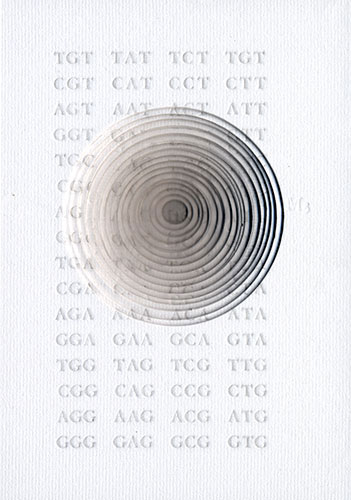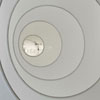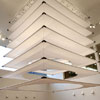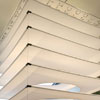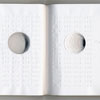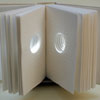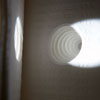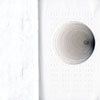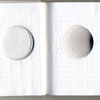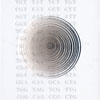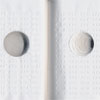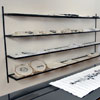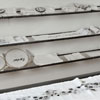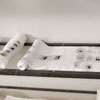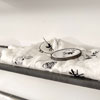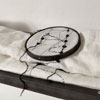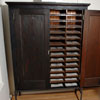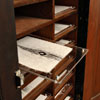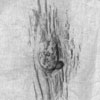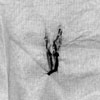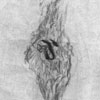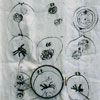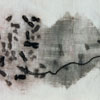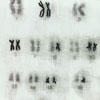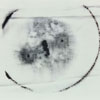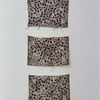M168: Tracing the Y Chromosome
Curated by Arthur DeBow
Works in exhibition
ARTIST’S STATEMENT
M168: Tracing the Y Chromosome is a physical metaphor for the lineage that all humans hold in their genetic structure. The installation consists of large muslin circular spaces, linens and books that are both metaphorical and literal maps of the migration of man’s DNA, from Africa to the Americas, over millions of years.
When my husband’s brother died recently, I felt as though a funnel had been drilled through the center of a book, rendering it un-readable. An entire body of knowledge had been taken from us. I became fixated on the images of a circular form – a funneling hole within a hole. At the time I was reading current research on tracing genetic linage through the Y chromosome. The thought occurred to me that because our DNA links all of us to each other and we inherit physical qualities from our ancestors, perhaps none of us completely disappears. Our DNA carries a string of proteins identified by the letters TCAG. This is a historical document stretching back through history. We are the result of over a billion years of evolutionary tinkering and our genes carry the spot welds that reveal the story.
This work, an installation of large muslin circles and books, is both a metaphorical and literal map of the migration of man from Africa to the Americas. The mapping of Y chromosomal markers is the work of geneticist Spenser Wells. He began this work in 1990 at Stanford University under Luca Cavalli-Sforza. Through his research he discovered that the Y chromosome has genetic markers that can be traced to specific geographic locations.] All men have the chromosomal marker M168 and can be traced to the Bush people of Africa.
M168 INSTALLATION
M168: TRACING THE Y CHROMOSOME, 2006
Muslin, dye sublimation prints on Ultra Sheer®, aluminum
9 x 10 x 10 ft.
The eight 10’ x 10’ muslin panels that occupy the center of the gallery create a phenomenological space. They are hung 5’ off the ground so that the viewer can enter the center opening of the circular form. The first of the eight layers has a 7’ diameter circle and each corresponding circle is one foot smaller. The last circle is 1’ in diameter. The white-on-white muslin lets through a soft filtered light. The standard genetic code is printed on the top layer of silk with the letters TACG and filters through the entire work. In the direct center is a layer of silk printed with M168, the chromosomal marker for the Bush people. The entire piece creates an empty space for the viewers to occupy; it is a space for contemplation.
LINENS
- Torah Binder, 2003–4
A Boy’s Chromosomes II
solvent transfer, embroidery thread, linen
- Torah Binder, 2003–4
A Boy’s Chromosomes I
solvent transfer, embroidery thread, linen - Torah Binder, Double Helix, 2005
solvent transfer, embroidery thread, linen - Egg Dividing, 2003
solvent transfer, embroidery thread, linen - Chromosome Splitting I, 2003–5
solvent transfer, embroidery thread, linen - Chromosome Splitting II, 2003–5
solvent transfer, embroidery thread, linen
Since 2002, I have made numerous embroideries on linen, which reference the history of domestic textiles, and decorative embroidery. I have embellished these textiles with genetic or cellular images, which document chromosomes or cell divisions. In the installation the shelves and table hold over 60 pieces in various sets. Several of the linens are based on Palestinian dress panels. Torah Binders, while other are dinner napkins, table runners and placements.
DESCRIPTIONS OF SELECTED WORKS
DRESS PANELS
The dress panel form relates to the Palestinian tradition of embroidering symbols relating to the woman’s family and village on the front of a dress. Most often these very elaborate panels reference the fertility and longevity of a women and her family. For this dress panel, I accessed photographs of actively dividing fetal cells in various stages of meiosis and mitosis. Each panel was printed from the same photo made with an electron microscope. The photo was reproduced using a photographic palmer plate on a Reprex® Letterpress on linen.
BINDERS
A BOY’S CHROMOSOMES I
Three of the pieces are based on a Torah Binder, specifically those made by the Ashkenazi Jews living in rural southern Germany from the 15th century until 1932. These binders were traditionally made from the circumcision diaper to document a boy’s life. A man’s birth, religious rituals, marriage, and death would be recorded in embroidery by his mother and later his wife. The chromosome tests used for these works were made from my own amniocentesis test (done at the 5th month of pregnancy). This test shows healthy chromosome pairs and indicates the sex of the child; in this case it is a boy, my son.
TABLE RUNNERS
CHROMOSOME SPLITTING II
The images used for this work are the first known drawings documenting fertilization, cleavage and the process of mitosis and meiosis, sequentially. These images are from Edouard Van Beneden’s paper published in 1883 titled, “Fertilization and Cleavage of the Ascaris Egg”. The image is embroidered on a 10’ linen table runner (see images on pp). For a full description of the works see pages.
M168 BOOKS
Table Runners
Chromosome Splitting II
The images used for this work are the first known drawings documenting fertilization, cleavage and the process of mitosis and meiosis sequentially. These images are from Edouard Van Beneden’s paper published in 1883 titled, “Fertilization and Cleavage of the Ascaris Egg”. The image is embroidered on a 10’ linen table runner (see images on pp). For a full description of the works see pages.
SET I: M168 BOOKS I– IV
4 books letterpress-embossed in Garamond 10-point type with the Standard Genetic Code, TCAG 3 x 5 in. each paper: I. vellum, II. Hoshu, III. Arches Cover, IV. rice paper die-cut with consecutive circles ranging from 2 in. to 1/8 in.
Chapters:
Each book is divided into 13 chapters tracing the markers on the Y chromosome from the last migration of Native Americans 10,000 years ago (M3) to the origins of humans 50,000 years ago in Africa (M168).
M3 Americas 10,000 years ago
M242 Siberia 10,000 years ago
M173 Northern Europe 30,000 years ago
M17 Indo-European and Steppes 10,000 years ago
M172 Mediterranean 10,000 years ago
M122 East Asia 10,000 years ago
M45 Central Asia 35,000 years ago
M175 Southeast Asia 35,000 years ago
M20 India 30,000 years ago
M9 Eurasian 40,000 years ago
M89 Central Middle East 45,000 years ago
M130 Australia 50,000 years ago
M168 Africa 50,000 years ago
SET II: ANOMALIES, M168 BOOKS I–IV
4 books letterpress-embossed in Garamond 10-point with the Standard Genetic Code including genetic anomalies connoting different races
3 x 5 in. each
paper: I. vellum, II. Honshu, III. Arches Cover, IV. rice paper
die-cut with consecutive circles ranging from 2 in. to 1/8 in.
Chapters:
Each book is divided into 13 chapters tracing the markers on the Y chromosome from the last migration of Native Americans 10,000 years ago (M3) to the origins of humans 50,000 years ago in Africa (M168).
M3 Americas 10,000 years ago
M242 Siberia 10,000 years ago
M173 Northern Europe 30,000 years ago
M17 Indo-European and Steppes 10,000 years ago
M172 Mediterranean 10,000 years ago
M122 East Asia 10,000 years ago
M45 Central Asia 35,000 years ago
M175 Southeast Asia 35,000 years ago
M20 India 30,000 years ago
M9 Eurasian 40,000 years ago
M89 Central Middle East 45,000 years ago
M130 Australia 50,000 years ago
M168 Africa 50,000 years ago
SET III: M3 BOOKS I–IV
4 books letterpress-embossed in Garamond 10-point type
3 x 5 in. each
paper: I. vellum, II. Hosho, III. Arches Cover, IV. rice paper
die-cut with consecutive circles ranging from 2 in. to 1/8 in.
Chapters:
Each book is divided into 13 chapters tracing the migratory patterns of humans, from Africa 50,000 years ago (M168) to the Americas 10,000 years ago (M3), as indicated on the Y chromosome.
M168 Africa 50,000 years ago
M130 Australia 50,000 years ago
M89 Central Middle East 45,000 years ago
M9 Eurasian 40,000 years ago
M175 Southeast Asia 35,000 years ago
M45 Central Asia 35,000 years ago
M173 Northern Europe 30,000 years ago
M20 India 30,000 years ago
M122 East Asia 10,000 years ago
M172 Mediterranean 10,000 years ago
M17 Indo-European and Steppes 10,000 years ago
M242 Siberia 10,000 years ago
M3 Americas 10,000 years ago
SET IV: BOOKS I–IV
4 blank books
3 x 5 in. each
paper: I. vellum, II. Hosho, III. Arches Cover, IV. rice paper
die-cut with consecutive circles ranging from 2 in. to 1/8 in.
All 16 3” x 5” books in this exhibition are unique hand bound letterpress embossed works based on the Y chromosome genetic markers. One set of four books is letterpress embossed with the “Table of Standard Genetic Code”. The second set of four has the “Standard Code “with the anomalies that identify each racial group. Both sets have a funneling hole cut into the center, taking out the core of information. The chromosomal marker number is letterpress printed at the right side of the whole, beginning with M3, or Native Americans, and ending with M168, the Bush people. These books trace the markers on the Y chromosomes from the last migration of first peoples 10,000 year ago to the origins of humans 40,000 years ago.
The third set of books has a funneling hole in the center with the chromosomal numbers letterpress printed at the bottom center like page numbers. This set begins with M168, the Bush people and ends with M3 in the center. These books trace the actual migration from 40,000 to 10,000 years ago. The fourth set of books are cut in the same circular form but are left blank. The books line the wall of the gallery space so that the viewer can look at each unique piece. Each book in a set is made with a different type of paper.
Like the genetic code itself, all of this work is a result of collaboration. The books were letterpress printed by Jesse Kauppila, Gelsey Kurrasch and Arini Esarey. The books were hand bound in cotton cloth by Warren Buss. The books were made at the Reed Press, Reed College Portland Oregon, in the summer of 2006.
Each book is meant to be opened and held. They are meditations on the duplication of genetic information and the uniqueness in each copy.
